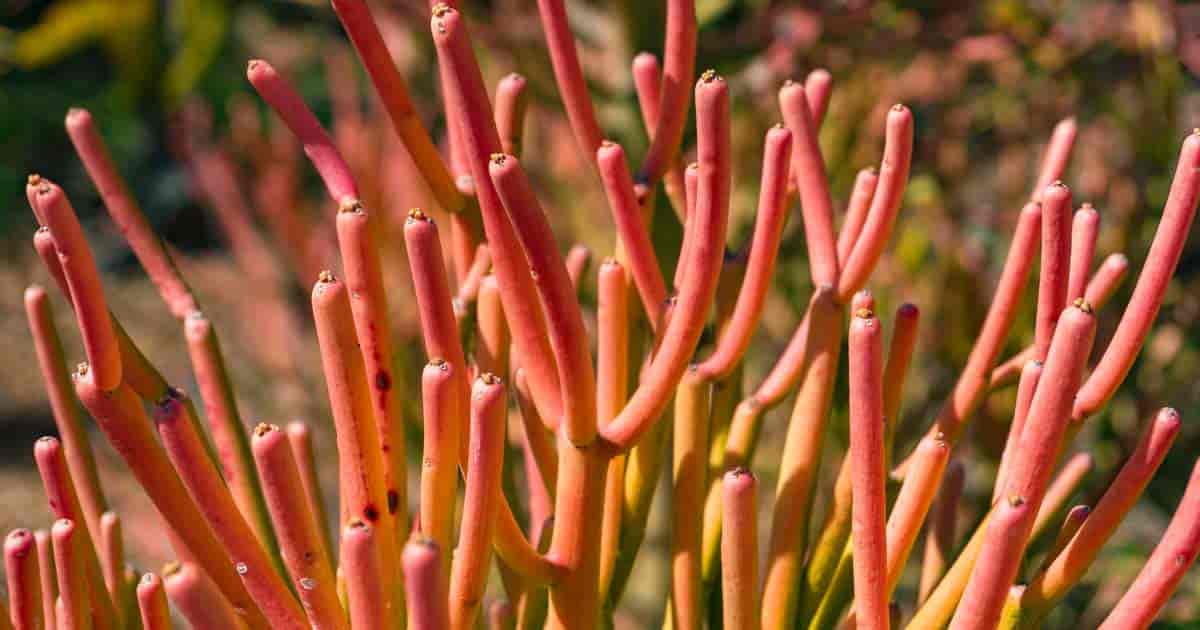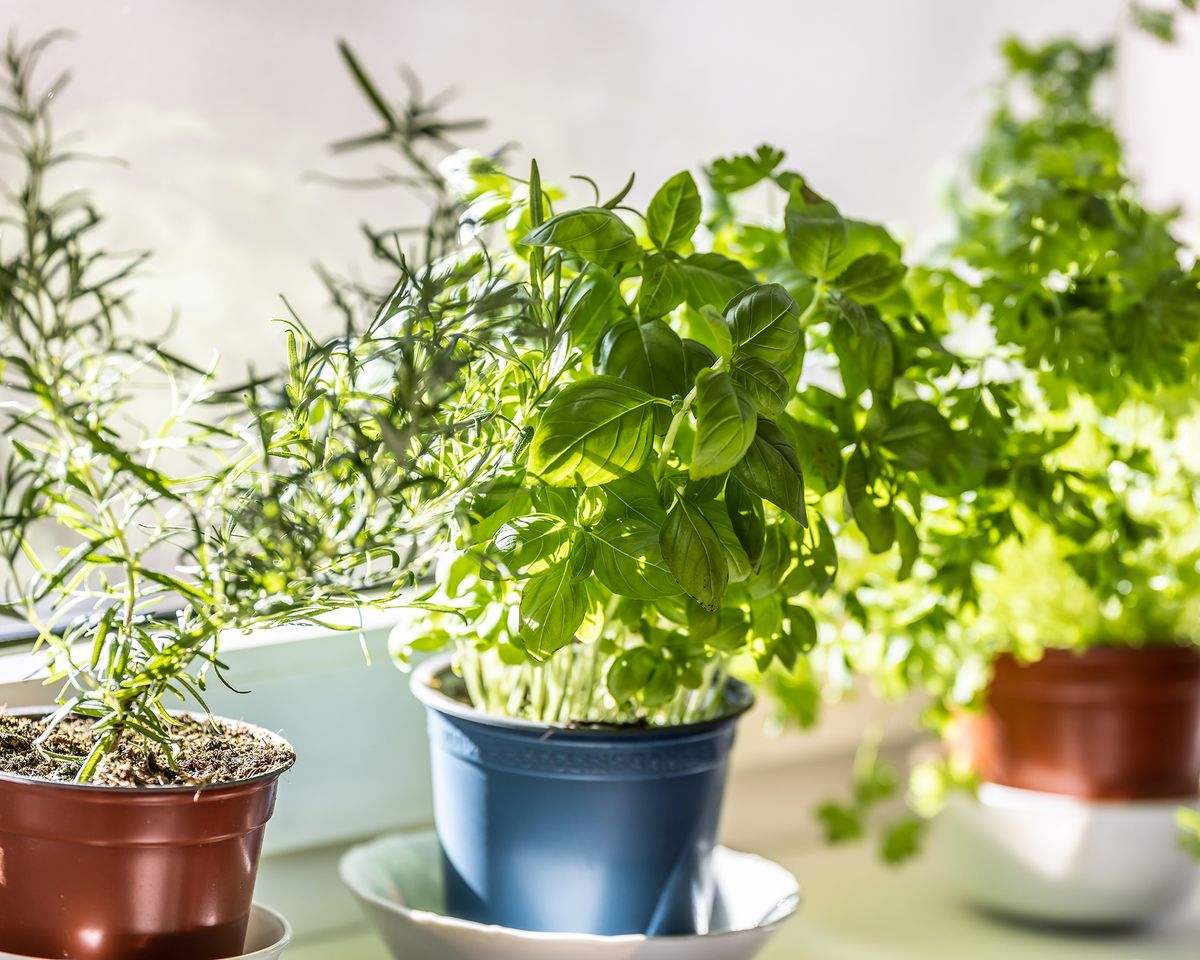Pencil Cactus (aka Euphorbia tirucalli or ET) is not a cactus. It is a rugged succulent plant that can grow to over 30’ feet high in the wild.
However, it can also be kept to a more moderate height of 6′ to 8′ feet when kept as a houseplant.

These attractive, interesting, and beautiful fire stick succulent plants take on a great deal of character as they age, and older plants develop thick inner branches with rough, gray, highly textured bark.
The foliage is an attractive shade of green throughout most of the year and transitions to yellow, orange, or red during the cooler months.
In this article, we will share information on growing, caring for, and appreciating this fascinating plant. Read on to learn more.
Firestick Plant Quick Growing Guide:
Family: Euphorbiaceae
Origin: South Africa, the Arabian peninsula, and India
Common Names: Rubber-hedge euphorbia (Eng.), Kraalmelkbos (Africa.), Indian tree spurge, Firestick Cactus, Pencil Cactus, Sticks on fire, Pencil plant, Finger Tree, Naked lady, Red Pencil tree, Milk bush, ET
Height: 6’ when kept indoors or in a container outdoors, 15′-30’ when grown as a landscape plant under ideal conditions.
USDA Hardiness Zones: 9A – 10A In the great outdoors, the plant is hardy to 25° degrees Fahrenheit. It does very well in average household temperatures and thrives in low humidity.
Flowers: Euphorbia tirucalli produces small yellowish flowers that attract butterflies, bees, and other insects. Firestick flowers grow in clusters at the apex or angle of the branches during the cooler months of the year.
Fruits: The fuzzy, pinkish fruits grow on short stalks in three-part clusters about 3/4″ of an inch in diameter.
Foliage: This plant’s leaves are tiny and thin, and you may miss them altogether as they fall off very soon after appearing. When the small leaves fall, they leave scars on the limbs which add to the visual interest of this plant.
Uses: These versatile plants have many uses. They are often kept indoors as a houseplant in contemporary interior designs, along with the prickly pear Opuntia cactus.
They are used as landscape plants in hot, dry climates.
When growing a pencil tree plant outdoors, the small flowers provide pollen for bees, and birds can safely eat the plant’s seeds.
In South Africa, a “rubber hedge” is often planted around livestock pens and other areas for privacy and to keep intruders out.
In African folk medicine, the sap may be used to treat sexual impotence and snakebite; however, this is not recommended as the sap is quite toxic, and it is also used to poison fish.
When grown in the wild, large, mature pencil trees yield very hard lumber used to make roof struts. [source]
Miscellaneous: In Venezuela and Columbia, ET is a very important biofuel crop. This video shows how it is grown and harvested. The video also provides good views of the plant in an ideal outdoor environment and good information on how to best care for and propagate it.
Pencil Fire Stick Plant Care Tips
Care varies somewhat depending on whether you want to keep your pencil plant indoors or outdoors.
Euphorbia Tirucalli Cactus Indoor Care
Light: This plant enjoys the full sun making it an excellent choice for a very sunny window setting. Rotate the plant periodically for balanced growth and even color development during the cooler months.
Water: The house plant should be watered weekly during the growing season. Take care to provide well-drained soil and plenty of drainage holes in the container to avoid root rot. Cut back to monthly watering during the cooler months.
Temperature: Although this plant can tolerate temperatures from 25º-100º degrees Fahrenheit, it prefers temperatures ranging from 50º – 70º degrees Fahrenheit. The ideal firesticks plant temperature range is 65º – 70º degrees Fahrenheit, so it does well year-round indoors at normal household temperatures.
Soil: Use high-quality, well-drained cactus or succulent potting soil with a pH of about 6.0.
Fertilizer: You may feed your finger plant seasonally with a controlled-release fertilizer or use a weak liquid houseplant food every week.
Mature plants do well with a 20-20-20 fertilizer. Younger plants do better with a lower nitrogen rating. Some people do not fertilize the pencil plant at all.
Tirucalli Sticks On Fire Cactus Outdoor Care
Light: Outdoors, the firestick plant does well with either partial or direct sun. It’s best to place this succulent shrub where it gets bright sun exposure on all sides for balanced growth and coloration.
Try to provide at least 5-6 hours of sunlight per day indoors so the plant receives enough light.
Keep away from direct sunlight while rooting to prevent burns. Water the soil every few days or when it feels dry.
Water: It’s better to give too little water than too much. Outdoors water this drought-tolerant pencil tree deeply about once a month during the growing season and once every couple of months during cool weather.
These drought-tolerant plants may do well with only rainwater. Cut back on watering and allow the plant to dry out and recover from too much water.
Soil: When planting outdoors, it’s a good idea to add some light, finished compost and/or some loam to your soil to improve its aeration and draining capabilities.
Fertilizer: If you keep a worm composting bin, you will find that a layer of worm compost or worm castings spread over the top of the soil annually provides all the nourishment your ET needs.
Pests and Diseases: With their toxic sap, these plants are fairly pest resistant.
Common succulent pests, such as plant mites, colonies of mealybugs, cactus scale, and aphids bugs on plants, may be a problem for over-watered and weakened plants, but for the most part, Euphorbia tirucalli is pest free. [source]
Pencil Cactus Propagation, Transplanting, & Repotting
If you plan on transplanting a milk bush, do it while the plant is still small. Moving a tall Firestick pencil cactus is difficult due to its weight and breaking branches.
Remember, you want to limit exposure to the toxic, irritating milky sap. The most common reason for mushy is overwatering.
If you want to relocate an outdoor red pencil tree, wear goggles, gloves, long pants, and a long-sleeved shirt.
Change clothes and wash up as soon as you are done.
NOTE: Some individuals may experience an allergic reaction to the toxic white sap, and some even have severe reactions. Do not keep the plant in a location where small children will come in contact with the plant.
Tirucalli Euphorbia Needs Repotting Frequently
These plants produce new growth rapidly, and you may need to repot annually or at least every couple of years. It’s best to allow the soil surrounding any succulent to dry before repotting.
Remove the plant from its pot and knock away or shake off all the dry potting soil. If the roots become damaged, treat affected areas with a fungicide to prevent root rot.
Put the plant into a new container and add a light, well-draining soil mixture. Standard cactus or a succulent mix works well. You may wish to add some light, finished compost to provide nourishment and relieve you of the task of fertilizing.
Don’t water the newly potted succulent for about a week. This will encourage root growth and discourage root rot.

Pencil Plant Propagation Is Easy
There’s not much need to relocate these plants because these cactus plants are so easy to propagate from cuttings.
Remember to protect yourself from the sap when taking cuttings. Dip the cut end in cold, fresh water to stop the sap from flowing.
Leave stem cuttings in the open air for a week or so to form a callous. Pop it into a pot of moist sand, succulent mix, or cactus mix. You’ll probably see growth within a week to 10 days.
Is The Firestick Succulent Poisonous?
When you picture the Pencil Cactus in your mind’s eye, you are unlikely to realize that it is closely related to such diverse plants as:
One thing these plants all have in common is irritating/toxic white sap. Despite precautions about the toxicity of the firestick plant, the sizeable shrubby succulent can create a stunning colorful landscape feature in a backyard.
All members of the Euphorbia family contain this poisonous, irritating sap. Euphorbia tirucalli is the most powerful of them all. That’s why it is so important to protect your eyes, hands, and skin when pruning.
Avoid casual contact with the plant. Place your “sticks on fire” plant carefully so people are not constantly brushing up against it and breaking its branches.
You should especially keep kids and pets away.
Related: Is The Firestick Plant Toxic Or Poisonous?
What You Need To Know About Pruning Fire Stick Plants
Euphorbia is used as a hedge plant in Africa due to its dense growing habit. Indoor plants may need trimming and tidying up to control size and improve appearance.
Outdoor plants able to grow freely will not need as much pruning. It’s a good idea to thin the stems from time to time to allow light and air circulation.
Indoors or outdoors, be sure to prune in a balanced way so the plant does not become top-heavy, causing landscaping plants to break and fall and potted plants to tumble over.
Always prune stems back to the main trunk. Don’t chop them off in the middle, as this produces an ugly appearance and causes the plant to branch out.
Drop cut branches into a tub of cold water to control the sap spillage. Wipe sap off the main trunk with a cool, damp cloth to help stop its flow and to prevent accidentally coming in contact with it as you work.
When pruning, take great care not to get the sap in your eyes or on your face. Topical exposure to the diterpene esters found in the sap can cause numbness, tingling, and burning sensations.
Getting the sap in your eyes can cause corneal damage and may result in temporary blindness.
If you get sap on your skin or in your eyes, flush with copious amounts of fresh water immediately.
When washing milk bush sap from the skin, wash gently with clean, running water. Don’t scrub or rub.
When flushing the eye, use clean, running water and continue flushing for about twenty minutes to be sure every trace is removed.
In either case, if this does not relieve your symptoms completely, seek medical assistance.
What To Do In Case Of Accidental Ingestion
If you have children or pets, be aware of the symptoms to watch for in the event of accidental ingestion.
- Burning in and around the mouth
- Irregular heartbeat
- Stomach cramps
- Skin Rashes
- Vomiting
- Seizures
- Asthma
The type of symptoms present and their severity depend upon the amount of the plant that is ingested. In case of ingestion, remove any remnants of the plant from the child or pet’s mouth and rinse with clean water.
If the victim is a child, follow up by calling your pediatrician or the Poison Control Center at 1-800-222-1222 immediately.
Follow instructions carefully, and remember to take a sample of the plant along with you if you are instructed to go to the emergency room.
If your child is experiencing high temperature, shortness of breath, seizures and/or unconsciousness, don’t waste time. Call 911. [source]
The latex sap found in Euphorbia is also toxic to cats, dogs, and equines (horses, donkeys, and mules). [source]
If you find your cat or dog is vomiting and/or experiencing irritation in and around the mouth, you may suspect pencil cactus poisoning.
With equines, you would see oral irritation, trouble swallowing, and symptoms of pain in the stomach and scour, but these animals cannot regurgitate.
If you think your pet has consumed Euphorbia tirucalli, call your veterinarian or the ASPCA poison hotline (888-426-4435) for advice. If you are instructed to bring your pet into your vet’s office or to an emergency clinic, be sure to take along a sample of the plant. [source]
Is It Safe To Keep The Euphorbia Firestick Cactus At All?
Dire as all this sounds, you needn’t go overboard with alarm.
There are lots of potentially poisonous plants, but luckily most of them taste terrible and accidental ingestion is rare.
If you place your pencil tree plant sensibly so people and pets are not constantly knocking up against it, you are unlikely to have problems with accidental skin contact exposure.
Just remember to be very careful when pruning, wear gloves, and wear eye protection. Pencil tree cactus doesn’t just drip sap. It has been known to squirt or spray it! [source]
Even The Worst Gardener Can Grow Happy, Healthy Pencil Plant Cactus
If you have a brightly lit, warm, dry space, you can expect your Pencil Tree to quickly and easily grow.
These unique-looking plants make attractive and unusual specimen plants in the garden, solarium, or greenhouse. They pair well with a beautiful container to dress things up.
It’s possible to control your plant’s size with regular pruning, but be sure to follow all the safety precautions we outlined here. Remember to place your plant where it can be seen but not bumped!
If you are a forgetful gardener or one who tends to be absent frequently, this drought-loving plant may be just the right choice for your sunny window, deck, or rock garden.
Pencil plants are easy to care for and demand so little. If you have lots of light and a little water, you and your pencil cactus will get along just fine.












